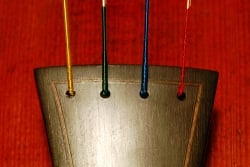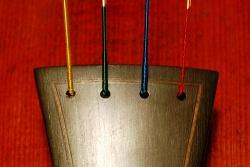
It's hard to be at your best when you don't take care of yourself, and your string instrument is no different. Neglect can lead to long term damage or, at the very least, your instrument not sounding its best.
Healthy Lifestyle
Along with your instrument, you should have rosin, an extra set of strings, and a cloth to dust your instrument and the shaft of your bow off before they go in the case. Protect your instrument from extreme temperatures — don't leave it in the car — and from humidity outside the 40-60 percent range. A hardware store will sell you a humidity meter for around $15.
Have your instrument restrung every one or two years (cellos and basses can last a little longer). You'll be happier with your sound on new strings. Depending on how often you play, your bow should be rehaired every six to eighteen months. If there is visible gunk on your bow-hair or if you have to rosin up every time you play, it's time. On that note, always try playing before you apply rosin. If your bow hair is in good shape you may be surprised at how infrequently you need it
Choosing your doctor
Taking care of your instrument begins with you, but some jobs are best left for the experts. If you are renting an instrument, the vendor will likely take care of the repair needs of your instrument. If you own your own instrument, any musician or music teacher should be able to recommend at least a couple of trustworthy shops. Find one close enough that you'll be willing to make the drive to keep your instrument healthy.
Keeping your finger on the pulse
Keep an eye on these four things to know whether a trip to the luthier might be necessary:
- If your violin or viola has fine-tuners (small metal screws attaching the string to the tailpiece), be careful that they don't become so tightened that they begin to dig a hole into the top of your instrument. The fix is easy: tune the string very flat with the fine tuner and use the peg to tune.
- Be careful that the rubber on the feet of your shoulder rest isn't deteriorated or brittle. This will lead to scratching through the varnish and into the wood.
- The bridge should be between the two horizontal dashes of the f-holes and the feet should be in full contact with the top of the instrument (not leaning toward the fingerboard or toward the tailpiece.) Try to slide a piece of paper underneath the feet of the bridge. Because the bridge is only held to the top by pressure, it will tend to move around as you use the instrument. This is an easy fix, but one that should only be done by someone with experience as it can easily become an expensive repair.
- It's not unusual for seams to open up on an instrument, especially student instruments and especially in drier environments (due to an air-conditioner or heater). These should be dealt with by a luthier immediately as they can quickly get out of hand.

